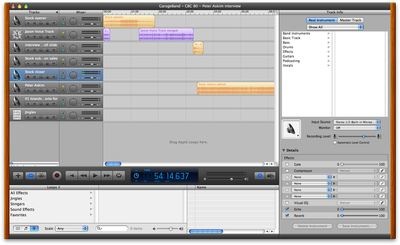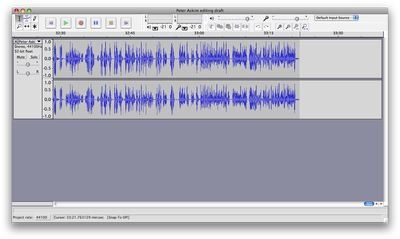Check out part 1 and part 2 of this series as well!
A significant chunk of my time these days is spent preparing, recording, editing, distributing, and promoting my podcast Contrabass Conversations, and even though I have always known that I’d have an easier time doing these tasks on a Mac, I’m a creature of habit, and I didn’t relish the thought of relearning all these tasks on a new operating system.
What goes into a podcast
There are a whole lot of small tasks that go into podcast creation and production, and one’s efficiency in handling all these tasks plays a major role in determining whether a podcast will take two hours to put together or twenty hours!
These tasks include:
- recording interviews
- writing scripts/dialogue
- recording host dialogue
- editing audio
- mixing in theme and background music
- encoding the podcast into a distribution format (MP3, MP4, etc.)
- uploading and promoting the material
Much more efficient podcasting on the Mac
After a few weeks spent adjusting to this new operating system and the new applications available to me, I’v discovered that I can massively cut down on the number of small but annoying tasks that always plagued my Windows podcasting workflow. This experience is strikingly similar to what I outlined for my blog workflow transition in part 2 of this series. Even though I’m basically doing the same tasks for blogging and podcasting on my new Mac set-up as I was doing on my old Windows set-up, the more seamless integration of programs and user-friendliness of the major applications has sped up my process considerably, leaving me more time to actually create content rather than futz with settings and file transfers.
Audacity versus Garageband
Figure 1: Audacity (open source software for PC, Mac, or Linux)
For the first 70+ episodes of Contrabass Conversations, I did nearly all of my mixing and editing in Audacity, a great piece of open-source software that is popular among many podcasters. Though I also have a copy of Sony SoundForge for the PC and use it for more complicated single-track editing projects, Audacity is perfectly adequate for mixing together the 5-20 individual tracks that I use for each podcast into a cohesive whole.
My Mac-using friends have long complained about Audacity’s constant crashing, which I always found peculiar-this program almost never crashed for me and was almost always extremely stable. As soon as I installed Audacity on my Mac, however, I understood all the carping about the product. It is extremely buggy and crash-prone on the Mac. It almost always crashes on me on the Mac, even after repairing permissions and doing other troubleshooting. What gives? Who knows…but it’s very irritating.
I’ve used GaregeBand on other people’s computers for quite some time, and I was always impressed with the ease of use and sleekness of the experience. I longed for a Mac and this product as I started my podcast in 2007. GarageBand is, after all, built for podcasting. Why wouldn’t anyone use it for a podcast?
Pros of GarageBand

Figure 2: GarageBand 3 (included with iLife ’08 for the Mac)
I made the move to GarageBand for my podcasts almost immediately after getting my new Mac, and though I had a couple of bumps in the road (I was very set in my ways after using Audacity for so long), I’ve come to really love it as a podcasting platform. The interface is set up very intuitively, with the most common podcasting tasks easily executed. Even minor features like dragging and dropping various tracks, labeling tracks, and assigning specific graphics to different tracks are a breeze in GarageBand.
Better track details – The track effects and details in GarageBand 3, while not as extensive as programs like Logic or SoundForge, are more than adequate for most podcasters, and the graphical layout makes it very easy to add or alter effects and also makes it clear what is being applied to a particular track.
Good plug-in incorporation – Plug-ins are also easily configured in GarageBand. For example, I regularly edit interviews with SoundSoap to remove background noise and other interference. On the PC, I would have to edit , apply, and save each individual track I was trying to edit before importing it into Audacity–a time-consuming and tedious process. With GarageBand, I was easily able to add SoundSoap as a plug-in. It now appears as an effect option on the menu in GarageBand, allowing me to incorporate it into a GarageBand project without having to edit it externally. Applying the effect is incorporated into the overall mixing and encoding process in GarageBand, streamlining the whole process and actually making me much more likely to use SoundSoap. Very cool.
Adding audio tracks is a snap – Being able to simply drag-and-drop any MP3, WAV, or AIFF audio file into a GarageBand project and have it either create a new track (by dragging it to an open space) or add it to an existing track (by dragging it to an appropriate space on an existing track) is a huge time saver, as is the integrated iTunes and media search functionality.
Easy background music and sound effects – Having all of GarageBand’s loops and jingles easily accessible for any podcast saves a ton of time. Doing this kind of thing in Audacity was extremely tedious. I actually would use my wife’s computer to create tracks in GarageBand (!), and then bring them over to the PC for importing. Talk about inefficient! Having all these great effects (with many more available online or through Apple’s Jam Packs) makes me much more likely to use them, and having the ability to ‘favorite’ ones I use a lot makes finding them a sap.
Cons of GarageBand
Though I really love using GarageBand for my podcasting, there are a few glaring negatives worth pointing out:
More resource-intensive than Audacity – GarageBand is a very cool program, but it’s a very hungry program–hungry for RAM and system resources. Even a new Mac with a fast processor can easily get bogged down in a large project, slowing to a crawl and possibly crashing if other programs are also being used. This is a drag. Audacity isn’t nearly as resource-intensive (though it actually crashes more frequently on the Mac!), and I never had my PC slow to a crawl while in the middle of editing an episode.
Doesn’t handle extremely long episodes well – My podcast often last over an hour, and (though I’ve heard that this has improved from prior versions of GarageBand), I’ve had some pretty disturbing GarageBand “freak-outs” when working on these longer episodes. I’ve actually had the final 1/3 of my episodes become completely silent–nothing I can do will bring back the audio on these files. Even after saving it out as an MP3, I end up with an audio file that is completely silent for the final 20 minutes. How annoying! I never had a problem with this on Audacity on the PC (though I wouldn’t be surprised if it happened on the Mac after my experiences with it).
Poor audio editing features – GarageBand may be many things, but it is definitely not an audio editor. Doing anything besides simple track splitting is a painful exercise in this program, necessitating the use of some other option for tightening up interviews and doing any other sort of editing that involves a lot of small snips.
Final Thoughts
After a month or so spent almost exclusively in the Mac environment, I’m loving it for blogging, podcasting, and every other task I’m doing on a daily basis. GarageBand, ecto, and Comic Life are actually helping me to be more flexible and creative, and programs like Yojimbo and Scrivener are helping me to better organize my digital life and be more effective.
One disturbing facet of Mac ownership: I’m spending all my money on cool applications now! But that’s for another post…
Bass News Right To Your Inbox!
Subscribe to get our weekly newsletter covering the double bass world.


Hi Jason nice job. Hope Apple will read it and start listening to podcasters demands. Regards from France
😈 This Site is shit! 👿
ok bitchs 😉 😆 😮 😛